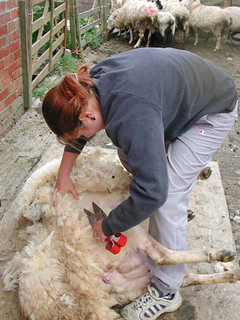 Shearing is the removal of the fleece (wool) from the sheep. Traditional shearing is done with shears, which look like scissors, and the animal is held in place so that there is no injury to both handler and the animal.³ The Code of Practice states that it is normal to shear the sheep annually and to additionally shear to allow the animal to see better and to prevent flystrike.² The Code of Practice also indicates that any cuts that the sheep incurs during shearing must be treated to prevent infection and flystrike.²
Shearing is the removal of the fleece (wool) from the sheep. Traditional shearing is done with shears, which look like scissors, and the animal is held in place so that there is no injury to both handler and the animal.³ The Code of Practice states that it is normal to shear the sheep annually and to additionally shear to allow the animal to see better and to prevent flystrike.² The Code of Practice also indicates that any cuts that the sheep incurs during shearing must be treated to prevent infection and flystrike.²
The main alternative to traditional shearing is Bioclip. Bioclip is sometimes referred to as “biological shearing” and has been available commercially since 1998.¹³ The sheep are fitted into a net and given an injection of Bioclip, which causes a ‘break’ in the wool fibres and the fleece is shed inside of the net.³ The process of shedding takes about a week and then the net and fleece can be removed from the sheep. The wool begins to grow again within 24 hours of shedding.³ Advantages to the handlers is that it minimises stress to the animals and also reduces variability to the length of the fibre and also lowers the loss of fibre from shearing³. There’s currently be no research that has indicated long term effects to the sheep health after having undergone Bioclip injections and all sheep that receive Bioclip go on to regrow their fleece.³
Photo by Flickr user northdevonfarmer.
¹ Holden, C. 1998. Self-shearing sheep. Science 281: 511.
² Primary Industries Ministerial Council 2006 Model Code of Practice for the Welfare of Animals – The Sheep, 2nd Edition. CSIRO Publishing, Collingwood.
³ WoolProducers Australia. 2007. About Wool. Available at:
http://www.woolproducers.com.au/about-wool/ Accessed Feb. 1 2012
